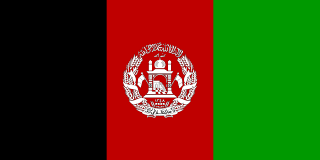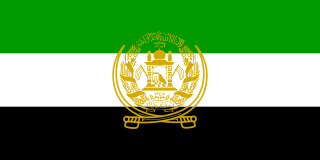
The government of Afghanistan is currently disputed following the effective collapse of the Islamic Republic of Afghanistan during the fall of Kabul to Taliban forces on 15 August 2021 and the subsequent re-establishment of the Islamic Emirate of Afghanistan which now exercises de facto control over most of the country. On 7 September 2021 the Taliban officials in de facto control of most of Afghanistan announced a new interim government headed by Mullah Mohammad Hassan Akhund as Prime Minister. The government is subject to the oversight of the Taliban's Supreme Leader, Haibatullah Akhundzada. As of 8 September 2021, the Islamic Emirate of Afghanistan has not yet been formally recognized as the de jure government of Afghanistan by any other country. The representatives appointed by the Islamic Republic of Afghanistan continue to represent the country at the United Nations. These representatives have refused to recognize the Taliban appointed government and have urged other countries to not recognize this government either.
The Afghan Constitution Commission was established October 5, 2002 as required by the Bonn Agreement, which stipulated that a new Afghan constitution be adopted by a loya jirga. The loya jirga was required to convene within eighteen months of the establishment of Afghan Transitional Administration, which was established by the Emergency Loya Jirga in June 2002. After some delay, the proposed Afghan Constitution was presented to President Hamid Karzai on November 3, 2003. A loya jirga began December 14, 2003 in Kabul and was endorsed January 4, 2004.
A 502-delegate loya jirga convened in Kabul, Afghanistan, on December 14, 2003, to consider the proposed Afghan Constitution. Originally planned to last ten days, the assembly did not endorse the charter until January 4, 2004. As has been generally the case with these assemblies, the endorsement came by way of consensus rather than a vote. Afghanistan's last constitution was drafted for the Democratic Republic of Afghanistan in November 1987.
Republican Party of Afghanistan is a political party in Afghanistan. When the party was founded in 1999, it declared the Universal Declaration of Human Rights as the programme of the party. Sebghatullah Sanjar was elected as the chairman of the party.

Afghanistan is divided into 34 provinces. The provinces of Afghanistan are the primary administrative divisions. Each province encompasses a number of districts or usually over 1,000 villages.
Operation Athena was the Canadian Forces' contribution to the International Security Assistance Force (ISAF) in Afghanistan. The operation was divided in two phases: the first one took place from July 2003 to July 2005 in the Kabul region and the second one from August 2005 to December 2011 in the Kandahar area. The operation's main objective was to improve Afghanistan's security and governance. Operation Athena in Kandahar constituted the longest combat mission in the history of Canadian Forces. With over 40,000 Canadian military units that, at some point, entered the country—often several times—this operation constitutes the largest military deployment of the Canadian Forces since World War II.

The Transitional Islamic State of Afghanistan (TISA), also known as the Afghan Transitional Authority, was the name of the temporary transitional government in Afghanistan put in place by the June 2002 loya jirga. The Transitional Authority succeeded the original Islamic State of Afghanistan, and preceded the Islamic Republic of Afghanistan (2004–2021).

Atta Muhammad Nur is an Afghan exiled politician and former militant who served as the Governor of Balkh Province in Afghanistan from 2004 to January 25, 2018. An ethnic Tajik, he worked to educate the Mujahideen after the 1979 Soviet invasion of Afghanistan, gaining the nickname "The Teacher". He then became a mujahideen resistance commander for the Jamiat-e Islami against the Soviets.
Gholam Rabani Nasher is a citizen of Afghanistan. Following the Bonn Conference that chose Hamid Karzai as Afghanistan's interim leader a Constitutional Loya Jirga was to write a new constitution. Nasher was one of the 502 delegates Karzai appointed. He sat on the third of the Jirga's ten committees. The Constitutional Loya Jirga sat from 2002 to 2004.

The Afghan Interim Administration (AIA), also known as the Afghan Interim Authority, was the first administration of Afghanistan after the fall of the Taliban regime and was the highest authority of the country from 22 December 2001 until 13 July 2002.

After Operation Enduring Freedom in which the Taliban government was toppled in Afghanistan, in December 2001, the German city of Bonn hosted a conference – widely known as the Bonn Conference – of Afghan leaders at Hotel Petersberg, to choose the leader of an Afghan Interim Authority and establish an initial political agreement for reorganising the governmental institutions of Afghanistan. The Conference chose Hamid Karzai, who was subsequently elected President in 2004. Karzai subsequently appointed many anti-Taliban allies and regional leaders to senior posts within the interim government and to senior posts in the Provincial governments. The Conference set up the Bonn Agreement for institutional reorganisation.

United Nations Security Council resolution 1386, adopted unanimously on 20 December 2001, after reaffirming all resolutions on the situation in Afghanistan, particularly resolutions 1378 (2001) and 1383 (2001), the Council authorised the establishment of the International Security Assistance Force (ISAF) to assist the Afghan Interim Authority in the maintenance of security in Kabul and surrounding areas. It was the final Security Council resolution adopted in 2001.

United Nations Security Council resolution 1419, adopted unanimously on 26 June 2002, after reaffirming all resolutions on the situation in Afghanistan, particularly Resolution 1383 (2001) and resolutions 1368 (2001) and 1373 (2001) on terrorism, the Council commended the country for the successful conduct of an emergency loya jirga and called for co-operation from the Afghan people with the Transitional Administration.

United Nations Security Council resolution 1536, adopted unanimously on 26 March 2004, after reaffirming all resolutions on the situation in Afghanistan, particularly Resolution 1471 (2003), the council extended the mandate of the United Nations Assistance Mission in Afghanistan (UNAMA) for an additional period of twelve months until 26 March 2005.

An emergency loya jirga was held in Kabul, Afghanistan between 11 and 19 June 2002 to elect a transitional administration. The loya jirga was called for by the Bonn Agreement and Bush administration. The agreement was drawn up in December 2001 in Germany. Conducted under United Nations auspices, the talks at Bonn sought a solution to the problem of government in Afghanistan after the US ousted the Taliban government.
Afghan leaders who met at the December 2001 Bonn Conference which picked Hamid Karzai to lead the Afghan Transitional Authority also agreed that a Constitutional Loya Jirga should be convened to draft a new constitution.

Zalmai Rassoul is an Afghan politician who served as Foreign Minister of Afghanistan from January 2010 to October 2013. He previously served as National Security Advisor from June 2002 to January 2010. Through his various roles in Government, Rassoul played a key role in building the Afghan security architecture, uniting the international community in support of an Afghan-led and Afghan-owned peace process, strengthening regional cooperation and security through the establishment of the Regional Economic Cooperation Conference on Afghanistan and the Heart of Asia-Istanbul Process, and rebuilding vital industries. He stood as a candidate in the 2014 presidential election.
The Truth and Justice Party or Hezb-e-Haq-wa-Adalat was a political party in Afghanistan. The party was multi-ethnic. Its members came from various ethnic groups, representing the Pashtuns, Tajiks, Hazaras, Uzbeks, Balochs and Nuristanis. Although led by a leadership council, the most prominent member and possible presidential candidate of the party is former interior minister under President Karzai and National Security Advisor under President Ghani Hanif Atmar.
Sayed Nasruddin Mohseni is a politician of Afghanistan. He is a leader of the Hizb e Wahadat e Islami—a party that serves members of Hazara ethnic group, who are from Islam's Sh'ia minority.

Sayed Ihsanuddin Taheri, or Sayed Ihsan Taheri, is an Afghan civil activist, politician and independent author, writer and blogger who was a 2012 World Vision International PeaceMaker Prize nominee. He was an official of the government of the Islamic Republic of Afghanistan, who has held various positions since 2002.












